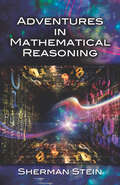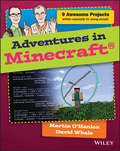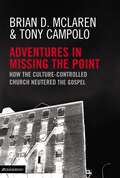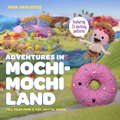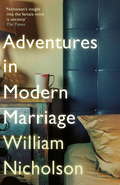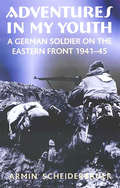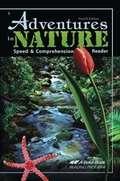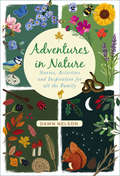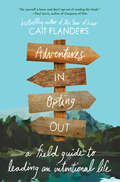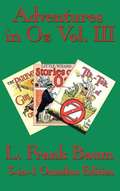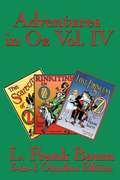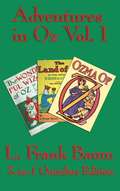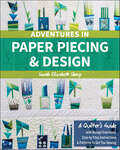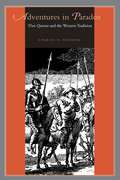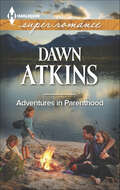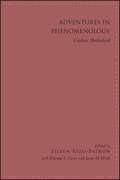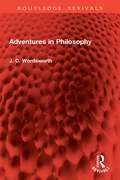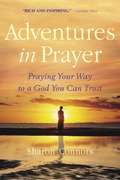- Table View
- List View
Adventures in Mathematical Reasoning
by Sherman SteinEqually appealing to beginners and to the mathematically adept, this book bridges the humanities and sciences to explore applications behind computers, cell phones, measurement of astronomical distance, cell growth, and other areas. Eight fascinating examples show how understanding certain topics in advanced mathematics requires nothing more than arithmetic and common sense.Each chapter begins with a question about strings consisting of nothing more than two letters, and every such question raises intriguing problems to be explored and solved. Author Sherman Stein proceeds at a measured pace that permits readers to move through the chapters in a leisurely fashion, omitting none of the steps. His approach makes complex subjects -- from topology to set theory to probability -- both accessible and exciting.
Adventures in Minecraft
by Martin O'Hanlon David WhaleHere's your ticket to a world of adventures with Minecraft and programming.Learn how to extend Minecraft and create a new gaming experience, by exploring the magical world of Minecraft programming. Adventures in Minecraft, like other books in the highly successful Adventures series, is written especially for 11- to 15-year-olds. With this book you will learn new programming skills while having fun with Minecraft! Minecraft programming experts David Whale and Martin O'Hanlon walk you step-by-step through everything you need to know to: Get started writing Minecraft programs in Python on your PC, Mac, or Raspberry Pi * Build houses and other structures in the blink of an eye, and make a 3D duplicating machine * Write interactive games like a field that charges you rent, and a treasure hunt using magic vanishing bridges * Build custom game control panels using simple electronic circuits * Easily build huge 2D and 3D structures such as spheres and pyramids * Build intelligent objects like a massive Minecraft clock, and program an alien invasion * Plan and write a complete interactive arena game * Using the programming skills you learn from this book, writing Minecraft programs offers endless possibilities to create anything you can imagine.
Adventures in Minecraft (Adventures In ... Ser.)
by Martin O'Hanlon David WhaleLearn valuable programming skills while building your own Minecraft adventure! If you love playing Minecraft and want to learn how to code and create your own mods, this book was designed just for you. Working within the game itself, you'll learn to set up and run your own local Minecraft server, interact with the game on PC, Mac and Raspberry Pi, and develop Python programming skills that apply way beyond Minecraft. You'll learn how to use coordinates, how to change the player’s position, how to create and delete blocks and how to check when a block has been hit. The adventures aren't limited to the virtual – you'll also learn how to connect Minecraft to a BBC micro:bit so your Minecraft world can sense and control objects in the real world! The companion website gives you access to tutorial videos to make sure you understand the book, starter kits to make setup simple, completed code files, and badges to collect for your accomplishments. Written specifically for young people by professional Minecraft geeks, this fun, easy-to-follow guide helps you expand Minecraft for more exciting adventures, and put your personal stamp on the world you create. Your own Minecraft world will be unlike anyone else's on the planet, and you'll pick up programming skills that will serve you for years to come on other devices and projects. Among other things, you will: Write Minecraft programs in Python® on your Mac®, PC or Raspberry Pi® Build houses, structures, and make a 3D duplicating machine Build intelligent objects and program an alien invasion Build huge 2D and 3D structures like spheres and pyramids Build a custom game controller using a BBC micro:bit™ Plan and write a complete interactive arena game Adventures in Minecraft teaches you how to make your favourite game even better, while you learn to program by customizing you Minecraft journey.
Adventures in Missing the Point: How the Culture-Controlled Church Neutered the Gospel
by Brian D. Mclaren Tony CampoloIf you’re brave enough to take an honest look at the issues facing the culture–controlled church–and the issues in your own life–read on. Do you ever look at how the Christian faith is being lived out in the new millennium and wonder if we’re not doing what we’re supposed to be doing? That we still haven’t quite “gotten it”? That we’ve missed the point regarding many important issues? It’s understandable if we’ve relied on what we’ve been told to believe or what’s widely accepted by the Christian community. But if we truly turned a constructive, critical eye toward our beliefs and vigorously questioned them and their origins, where would we find ourselves? Best-selling authors Brian McLaren and Tony Campolo invite you to do just that. Join them on an adventure–one that’s about uncovering and naming faulty conclusions, suppositions, and assumptions about the Christian faith. In Adventures in Missing the Point, the authors take turns addressing how we’ve missed the point on crucial topics such as: Salvation, The Bible, Being Postmodern, Worship, Homosexuality, Truth, and many more…
Adventures in Mixed Media Art: Inspiration, Techniques and Projects for Painting, Collage and More
by Amy JonesAre you inspired by mixed-media art but don't know where to start?Adventures in Mixed Media Art is the ultimate guidebook for embarking on your own creative adventure! Featuring 20 favorite mixed-media projects from the bestselling North Light backlist, this "best of the best" collection will motivate any would-be artist to start creating!Beginning with motivational readings, you will discover and learn to refine your creative energy by discovering what inspires you. Then you are ready to create your very own art journal using guided mixed-media techniques, including hand lettering and basic painting and collage techniques.When you're ready to create and refine your signature style, you'll start creating canvas paintings, collages and assemblage pieces based on projects from popular mixed-media artists like Dina Wakley, Mary Beth Shaw, and more. Even if your project doesn't turn out as planned, the book includes helpful tips and techniques for repurposing those pieces into a new work of art you can proudly display. The book also includes collaborative projects so you can encourage others to start their own Adventures in Mixed Media!
Adventures in Mochimochi Land
by Anna HrachovecWhat do a talking doughnut, a crabby politician, and a lovelorn balloon have in common? They're all citizens of the candy-colored knitted world known as Mochimochi Land. Adventures in Mochimochi Land started out as a collection of tiny knitted characters, but as the patterns grew they needed an entire world of their own, complete with knitted cities, knitted forests, knitted oceans, and most important, knitted friends! The book follows the adventures of a tiny knitted explorer, as he travels this unbelievably cute world and uncovers its strange yarn-based origins. For intrepid knitters, the book also includes a section with 25 all-new patterns for the characters and props used in the stories. The patterns use small amounts of yarn and beginner-friendly knitting skills and knit up quickly for instant fun.
Adventures in Modern Marriage
by William NicholsonWith pace, wit and a beady eye, Adventures in Modern Marriage revisits the characters from Nicholson's highly acclaimed The Secret Intensity of Everyday Life. But now the children are grown up, and the adults are older, though not always wiser. Here is a big-hearted novel about life and love in the bestselling vein of Colm Toibin and Nick Hornby'So incredibly accurate and true. Utterly captures the sense of quiet desperation of ordinary lives ... and the ways in which life turns on a sixpence' Kate Mosse on The Secret Intensity of Everyday LifeFocusing on Henry and Laura Broad and their daughter Carrie, this is a minute - but in true Nicholson style, extraordinarily empathetic - dissection of relationships and what keeps them going. It is an acute and compassionate look at male mid-life crises, female sexual desire, death and the fear of it, children and the trouble with them - all the things we battle with every day.
Adventures in My Youth: A German Soldier on the Eastern Front 1941–45
by Armin ScheiderbauerThe author could be described as a 'veteran' in every sense of the word, even though he was only aged 21 when the war ended. Armin Scheiderbauer served as an infantry officer with the 252nd Infantry Division, German Army, and saw four years of bitter combat on the Eastern Front, being wounded six times. This is an outstanding personal memoir, written with great thoughtfulness and honesty.Scheiderbauer joined his unit during the winter of 1941/42, and during the following years saw fierce combat in many of the largest battles on the Eastern Front. His experiences of the 1943-45 period are particularly noteworthy, including his recollections of the massive Soviet offensives of summer 1944 and January 1945. Participating in the bitter battles in East Prussia, he was captured by the Soviets and not released until 1947.Adventures in my Youth is a unique memoir—the author originally wrote it only for his daughter. It has never been published in any language, until now.
Adventures in Nature: Speed and Comprehensive Reader
by Marion Hedquist Michelle Johnson Dawn Mereness Phyllis RandBeginning in fourth grade, the reading program provides specific opportunities for students to develop comprehension skills. At this level, students are responsible for much more history and science material and outside reading. Their vocabulary work is increased, and they are expected to retain many more facts. Begin now to stress the importance of reading for information at the best possible speed. Because the reading program for the lower elementary grades stresses phonics and reading mastery, students are now ready to work on these other reading skills.
Adventures in Nature: Stories, Activities and Inspiration for all the Family
by Dawn NelsonThrough a mixture of original stories and traditional tales, Adventures in Nature offers an abundance of ways for families to connect with the earth. As our ancestors did before us, the book follows the seasons contained in the ‘Wheel Of The Year’, with each entry focusing on a story that brings us closer to the natural world, accompanied by simple craft projects, activities and mindful moments.In our busy, modern lives we have become increasingly disconnected from the world around us, and stories are an age-old way of re-establishing that link, nurturing a love for the environment and embedding awareness and respect for the planet within our culture.This book allows you to discover your very own adventures in nature through story.
Adventures in Opting Out: A Field Guide to Leading an Intentional Life
by Cait FlandersOpt out of expectations and live a more intentional life with this refreshing guide from the national bestselling author of The Year of Less.We all follow our own path in life. At least, that's what we're told. In reality, many of us either do what is expected of us, or follow the invisible but well-worn paths that lead to what is culturally acceptable. For some, those paths are fine -- even great. But they leave some of us feeling disconnected from ourselves and what we really want. When that discomfort finally outweighs the fear of trying something new, we're ready to opt out.After going through this process many times, Cait Flanders found there is an incredible parallel between taking a different path in life and the psychological work it takes to summit a mountain -- especially when you decide to go solo. In Adventures in Opting Out, she offers a trail map to help you with both. As you'll see, reaching the first viewpoint can be easy -- and it offers a glimpse of what you're walking toward. Climbing to the summit for the full view is worth it. But in the space between those two peaks you will enter a world completely unknown to you, and that is the most difficult part of the path to navigate. With Flanders's guidance and advice, drawn from her own journey and stories of others, you'll have all the encouragement and insight you'll need to take the path less traveled and create the life you want. Just step up to the trailhead and expect it to be an adventure.
Adventures in Other Lands Speed and Comprehension Reader
by Matilda NordtvedtHelp boost your child’s reading speed and comprehension with Adventures in Other Lands. This book includes exciting reading exercises about children living in foreign countries such as Japan, Peru, Bolivia, and more. Each story lists the number of words in the selection and includes a removable quiz to test your child’s understanding of the passage. Complete with an Answer Key and a Reading Record Sheet, this reader allows you to evaluate and track your child’s progress as he advances in reading speed and comprehension.
Adventures in Oz
by L. Frank BaumExplore the wonder of Oz in this collection of books seven through nine in L. Frank Baum's classic American fairy tale series. The seventh, eighth, and ninth titles of the iconic Oz series, now in one collection! In The Patchwork Girl of Oz, the Munchkins Unc Nunkie and Ojo the Unlucky call on the Crooked Magician, who introduces them to his latest creation: a living girl made out of patchwork quilts and cotton stuffing. But when an accident leaves beloved Unc Nunkie a motionless statue, it is up to Ojo to save him. Can the mighty Wizard of Oz help? In Tik-Tok of Oz, Betsy Bobbin and her loyal mule, Hank, wash up on the shores of an unknown fairyland during a storm. There they meet the clockwork man Tik-Tok and find themselves trapped in a battle with the king of the Nomes. In The Scarecrow of Oz, Cap'n Bill and Trot journey to Oz and, with the help of the Scarecrow, overthrow the cruel King Krewl of Jinxland, who has been busy gathering an army for an invasion of Oz. Will they be able to stop the invasion?
Adventures in Oz
by L. Frank BaumExperience Oz like never before in this collection of books ten through twelve in L. Frank Baum's classic American fairy tale series. The tenth, eleventh, and twelfth titles of the iconic Oz series, now in one collection! In Rinkitink in Oz, Prince Inga of Pingaree must rescue his parents and all of the subjects from his kingdom who were kidnapped by marauders form Regos and Coregos. Prince Inga, along with the visiting King Rinkitink and Bilbil the goat, set off on a series of grand adventures that will lead them to the underground kingdom of the Nome King. Will Inga's bravery and courage be enough to save his parents and all of their subjects? In The Lost Princess of Oz, Ozma, the beloved ruler of Oz, has disappeared, so Dorothy, the Wizard, the Cowardly Lion, and a band of friends must search the vast land of Oz to find her. In The Tin Woodman of Oz, Tin Woodman, Woot the Wanderer, and Captain Fyter set off on a quest to find the lovely Munchkin, Nimmie Amee. Once upon a time, she and the Woodman were going to marry, but then the Wicked Witch of the West turned him to tin. Can the Tin Woodman find Nimmie Amee? And will she remember him?
Adventures in Oz
by L. Frank BaumRevel in the magic of Oz in this collection of the final three books in L. Frank Baum's classic American fairy tale series. The three concluding titles of the iconic Oz series, now in one collection! In The Magic of Oz, the mischievous Kiki Aru has discovered a magical word that can transform him and anyone else into whatever he wants. Worse yet, Kiki has been recruited by the villainous Nome King in his latest attempt to get revenge on Princess Ozma and all her friends. Can Dorothy and the Wizard stop the evildoers before they conquer Oz? Or will Kiki's incredible powers finally give the Nome King the revenge he has craved for so long? In Glinda of Oz, Dorothy and Ozma journey to a remote part of Oz to stop a war between the Flatheads and the Skeezers. But the Flatheads and Skeezers have a different idea. Soon Ozma and Dorothy are trapped in an amazing crystal-domed city on an enchanted island. The watertight city submerges itself, and only the Wizard and Glinda can save them--but will they make it in time? In The Royal Book of Oz, the Scarecrow goes to search for his family roots. He returns to the cornfield where Dorothy first found him and discovers that he is the Long Lost Emperor of the Silver Island. Will he decide to stay there? Or will he return to Oz?
Adventures in Oz
by L. Frank BaumFor generations L. Frank Baum's Land of Oz books have captured and enthralled millions of readers. These stories are as delightful today as they were the day they were written. This omnibus edition contains the first three books: The Wonderful Wizard of Oz, The Marvelous Land of Oz, and Ozma of Oz! Now you can join Dorothy as an earthquake sends her to the land of Mangaboos and the vegetable people in the Dorothy and the Wizard in Oz; journey with Dorothy and Toto as they meet the Shaggy Man, Button-Bright, and Polychrome in The Road to Oz; and in The Emerald City of Oz, Dorothy brings Aunty Em and Uncle Henry along for the adventure!
Adventures in Paper Piecing & Design: A Quilter's Guide with Design Exercises, Step-by-Step Instructions & Patterns to Get You Sewing
by Sarah Elizabeth SharpTurn your interest in foundation paper-piecing into a full-blown love affair. Learn about every stage of the process—from piecing technique to pattern design—in this comprehensive guide. Start with the basics of sewing on paper, then explore the author’s open-ended design exercises to create your own patterns or follow along with the author’s take to sew her graphic interpretations of the prompts. With an annotated overview of the author’s favorite FPP methods, countless tips, and over thirty paper-pieced quilt blocks plus seven design exercises to put your skills to the test, you’ll have the tools you need to thrive when confronted with any paper-piecing challenge! - Build your piecing skills with over thirty graphic paper-pieced blocks inspired by everything from house plants to typography to surface pattern design techniques - Learn how to translate your own reference images or sketches into FPP patterns - Sharpen your pattern-design skills with choose-your-own-adventure style exercises "
Adventures in Paradox: Don Quixote and the Western Tradition (Studies in Romance Literatures)
by Charles D. PresbergCervantes’s Don Quixote confronts us with a series of enigmas that, over the centuries, have divided even its most expert readers: Does the text pursue a serious or comic purpose? Does it promote the truth of history and the untruth of fiction, or the truth of poetry and the fictiveness of truth itself? In a book that will revise the way we read and debate Don Quixote, Charles D. Presberg discusses the trope of paradox as a governing rhetorical strategy in this most canonical of Spanish literary texts. To situate Cervantes’s masterpiece within the centuries-long praxis of paradoxical discourse in the West, Presberg surveys its tradition in Classical Antiquity, the Middle Ages, and the European Renaissance. He outlines the development of paradoxy in the Spanish Renaissance, centering on works by Fernando de Rojas, Pero Mexía, and Antonio de Guevara. In his detailed reading of portions of Don Quixote, Presberg shows how Cervantes’s work enlarges the tradition of paradoxical discourse by imitating as well as transforming fictional and nonfictional models. He concludes that Cervantes’s seriocomic "system" of paradoxy jointly parodies, celebrates, and urges us to ponder the agency of discourse in the continued refashioning of knowledge, history, culture, and personal identity.This engaging book will be welcomed by literary scholars, Hispanisists, historians, and students of the history of rhetoric and poetics.
Adventures in Parenthood
by Dawn AtkinsForget Everest...parenting is a real challenge There aren't many adventures Aubrey Hanson hasn't tried. But parenthood and domestic duties are definitely not for her. Then her twin nieces are orphaned and suddenly Aubrey needs those skills! There's one problem-their gorgeous uncle, Dixon Carter. Officially, he's their guardian and he wants Aubrey involved, just not in charge. Unofficially...well, the spark that caused their almost night together still simmers. In fact, it's threatening to get out of control and disrupt raising the twins. Aubrey and Dixon can't keep the attraction a secret forever. So they need to figure out how to be together...with kids!
Adventures in Parenthood
by Denise Van OutenIn her second parenting book, Denise van Outen recounts, with her trademark warmth and honest, down-to-earth attitude, the joys and challenges of motherhood following the birth of her daughter Betsy with Lee Mead. ADVENTURES IN PARENTHOOD tells the trials and tribulations of those first 18 months of parenthood, when everything is new. Denise believes it's important to be open and to share as a new mum - she has spoken out about breastfeeding and being a working mum in the press - and this book does exactly that. Denise draws not just on her own experience, but also those of her non-celebrity friends. Some of her Twitter followers have also added their own advice and experience. This frank and honest account from Denise is a great holiday read for any new parent who is wondering if anyone else is feeling the same way they are - the answer is usually yes!
Adventures in Parenthood
by Denise Van OutenIn her second parenting book, Denise van Outen recounts, with her trademark warmth and honest, down-to-earth attitude, the joys and challenges of motherhood following the birth of her daughter Betsy with Lee Mead. ADVENTURES IN PARENTHOOD tells the trials and tribulations of those first 18 months of parenthood, when everything is new. Denise believes it's important to be open and to share as a new mum - she has spoken out about breastfeeding and being a working mum in the press - and this book does exactly that. Denise draws not just on her own experience, but also those of her non-celebrity friends. Some of her Twitter followers have also added their own advice and experience. This frank and honest account from Denise is a great holiday read for any new parent who is wondering if anyone else is feeling the same way they are - the answer is usually yes!
Adventures in Phenomenology: Gaston Bachelard (SUNY series in Contemporary French Thought)
by Eileen Rizo-Patron; Edward S. Casey; Jason M. WirthLike Schelling before him and Deleuze and Guattari after him, Gaston Bachelard made major philosophical contributions to the advancement of science and the arts. In addition to being a mathematician and epistemologist whose influential work in the philosophy of science is still being absorbed, Bachelard was also one of the most innovative thinkers on poetic creativity and its ethical implications. His approaches to literature and the arts by way of elemental reverie awakened long-buried modes of thinking that have inspired literary critics, depth psychologists, poets, and artists alike. Bachelard's extraordinary body of work, unduly neglected by the English-language reception of continental philosophy in recent decades, exhibits a capacity to speak to the full complexity and wider reaches of human thinking. The essays in this volume analyze Bachelard as a phenomenological thinker and situate his thought within the Western tradition. Considering his work alongside that of Schelling, Husserl, Bergson, Buber, Heidegger, Merleau-Ponty, Gadamer, Deleuze, and Nancy, this collection highlights some of Bachelard's most provocative proposals on questions of ontology, hermeneutics, ethics, environmental politics, spirituality, and the possibilities they offer for productive transformations of self and world.
Adventures in Philosophy (Routledge Revivals)
by J. C. WordsworthFirst published in 1925, Adventures in Philosophy presents a series of essays dealing with some of the chief problems of metaphysics and beginning with a defence of that somewhat unpopular pursuit. The first part of the book is mainly constructive in character, and not only attempts to put as clearly as possible the metaphysical views of the author but indicates their consequences from an ethical standpoint. The later chapters discuss two of the most important developments in philosophy associated with the names of Einstein and Bergson. Finally, the author considers how far religion, especially the Christian religion, is affected by the conclusions reached earlier in the book. This is an important historical reference for students and scholars of philosophy.
Adventures in Prayer
by Sharon ConnorsPrayer has surged in popularity along with a huge widespread interest in spirituality. Yet in the midst of this, the most frequent questions concerning many who pray are: How should I pray? How does prayer really work? and How can prayer work for me? If we don't really know how to pray effectively, then the process could prove to be hit and miss – with results often being inconsistent. But as ordained minister Sharon Connors reveals, prayer is something that we can all do, and which has the potential to transform our lives – we just have to understand the basic principles and techniques that make it work. ADVENTURES IN PRAYER provides the key to successful prayer. It explains exactly how prayer works, offering a way for people to connect with a higher power, and to answer their deepest questions and needs. Sharon Connors has had extensive – and diverse – prayer experience throughout her ministry, and her approach to prayer is both non-denominational and non-religious, applicable to readers of all faiths and backgrounds who want to heighten their spiritual experience. With clear and simple guidelines, this book shows how we can use prayer successfully to achieve spiritual harmony and wellbeing in all aspects of our lives, including: making difficult decisions, handling change, healing, finding our true purpose, and bringing ourselves closer to the divine in our daily lives.
Adventures in Prayer: Praying Your Way to a God You Can Trust
by Sharon ConnorsThis book is about creating a better life through prayer. Sharon Connors tested the power of prayer over and over as she grew from a frightened, impoverished, but determined single mother of two children to a senior minister who has brought the gift of prayer to thousands. The people she works with ask basic questions like: How should I pray? What if I'm afraid of God or angry at God? How do I know prayer is working? Is it all right to pray for myself and for specific things I want? How can I build my faith? This step-by-step guide provides honest, practical answers--and the inspiration to act on them.Sharon Connors teaches prayer as a learnable technique that improves with daily practice. She interweaves basic principles with moving personal stories from her own life and those she has served, and offers dozens of original prayers and affirmations that address readers' most urgent needs. Building on the conviction that the human mind is a powerful creative force designed to communicate with God, she first shows how to focus the power of mind in prayer. In each chapter that follows, she describes how to use prayer in specific circumstances, including: Healing broken relationships Seeking guidance in times of confusion Transforming the fear of change and mastering life's storms Building prosperity Learning to forgive Finding your purpose in lifeThe final chapter, "Creating Miracles," teaches the "four ways of gratitude," which have the greatest power to turn around our lives.Reverend Connors has explored a wide range of prayer and healing approaches from many spiritual traditions, and these diverse practices are reflected in her book.From the Hardcover edition.
